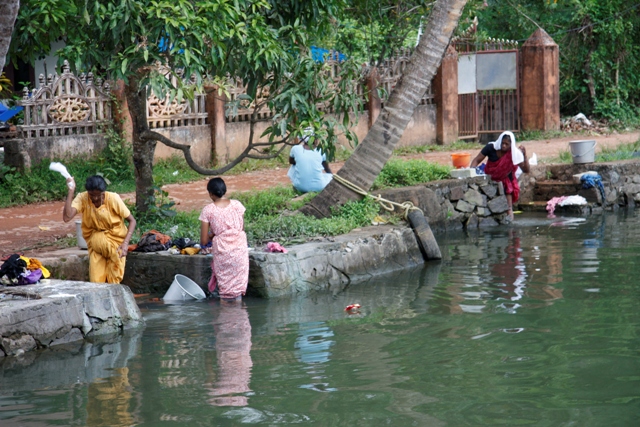Leaving the lovely beach resort of Tavancore, it was a long slow trip of about 120km to the shores of Lake Vembanad near Kumarakom. This lake rose to prominence as the main transport route of rice to the port of Kochin about 100 km from the end of the lake. Rice boats still ply their way lazily along the backwaters, now mainly involved in the tourist trade.
(Check on the blog archive, November 2010 for Part 1.)
Part 2: Kumarakom, Rice boat country.
Arriving after a hot humid trip from the beach at Kovalam, it was time to check in to our resort on the shores of Lake Vembanad.
Being on the lake edge there was plenty of boats plying back and forward all day and night. The next morning we went for an explore with the camera and found a number of different species of dragon fly. The photos below are all centre crops from the images taken by my Canon 450D.
This is the closest we got to any wild life in India in their natural habitat. We did see elephants but they were working and lumbering along the road with heavy chains around their legs and feet. There were a few birds around as well but we were there at the wrong time of the year to see those that migrate and rest on the backwaters around the lake.
A water hyacinth, which apparently came from Thailand is slowly spreading through the lake and will eventually choke off the lively-hood of local villagers who rely on fishing. The rice boats have to stop when they reverse and clear the weed from around the rudder and propeller.
One way of controlling the hyacinth is to open the gates (the lake is at sea level) and let salt water infiltrate. The hyacinth doesn't like salt, but this only has a limited effect near the outlet. Huge quantities of freshwater pour in during the monsoon to complicate things as well. There is talk of a spraying campaign as a last resort. An ecological disaster already in the making, what damage will spraying do?
A rice boat tour is the thing to do in this part of India. We opted for a four hour tour but the last two hours were out in the lake and as result didn't see too much. A two hour trip would do.
Back from out lake cruise we were entertained before dinner by some Kerala dancing. Not understanding Indian music and the use of hands to express feelings during the dance, the show didn't do much for me - been there, seen that .........
Two nights at Kumarakom and it was time to move on.
When planning this trip we had heard about the Periyer Wildlife Sanctuary and Tiger Reserve. We meet up with several people who had been there and seen no animals at all, a few birds and as far as tigers are concerned, there are some but very elusive. I am pleased we decided not to stop there on the way as the next trip was 5 hours and 140 km with hardly any stops.
Next stop was tea country around Munnar in the Western Ghats.
India, Part 3: Munnar, Tea country
(Check on the blog archive, November 2010 for Part 1.)
Part 2: Kumarakom, Rice boat country.
Arriving after a hot humid trip from the beach at Kovalam, it was time to check in to our resort on the shores of Lake Vembanad.
 |
| Waterscapes Resort. A rather tired 3 star resort but perfectly clean, comfortable and in a wonderful setting. |
 |
| Rice boats on Lake Vembanad |
 |
| Dragon fly 1, Canon EF-S 55-250mm at 250mm, f/6.3, 1/100s, ISO-200 |
 |
| Dragon fly 2, Canon EF-S 55-250mm at 250mm, f/8, 1/160s, ISO-200 |
 |
| Dragon fly 3, Canon EF-S 55-250mm at 250mm, f/5.6, 1/640s, ISO-400 |
 |
| Dragon fly 4, Canon EF-S 55-250mm at 250mm, f/5.6, 1/400s, ISO-400 |
 |
| Rice boat tours right up to the hotel |
One way of controlling the hyacinth is to open the gates (the lake is at sea level) and let salt water infiltrate. The hyacinth doesn't like salt, but this only has a limited effect near the outlet. Huge quantities of freshwater pour in during the monsoon to complicate things as well. There is talk of a spraying campaign as a last resort. An ecological disaster already in the making, what damage will spraying do?
 |
| You can stay overnight on these. |
 |
| One of the backwaters |
 |
| Typical backwater scene. Hundreds of kilometres like this. |
 |
| Backwater taxi. |
 |
| Backwater transport |
 |
| No electric washing machines here. |
 |
| Threshing rice |
 |
| Chinese fishing nets. Not in use because of the weed choking the lake. |
 |
| Kerala dancer. |
Two nights at Kumarakom and it was time to move on.
When planning this trip we had heard about the Periyer Wildlife Sanctuary and Tiger Reserve. We meet up with several people who had been there and seen no animals at all, a few birds and as far as tigers are concerned, there are some but very elusive. I am pleased we decided not to stop there on the way as the next trip was 5 hours and 140 km with hardly any stops.
Next stop was tea country around Munnar in the Western Ghats.
India, Part 3: Munnar, Tea country
No comments:
Post a Comment